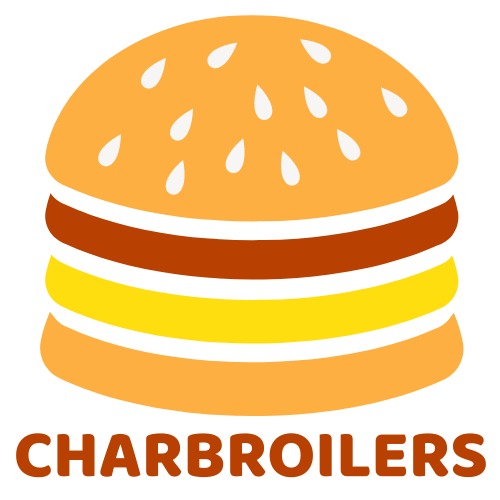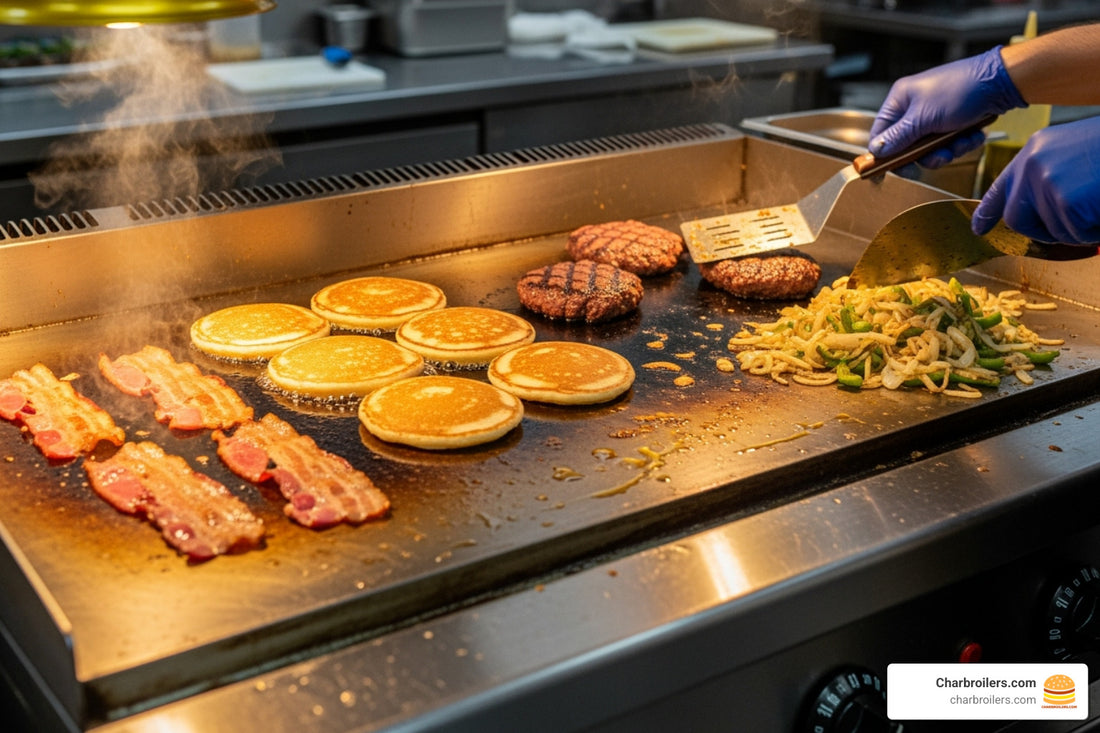
The Ultimate Commercial Flat Top Grill Roundup: Sizzle Up Your Menu
Share
Why a Flat Top Grill is Your Kitchen's MVP
A commercial flat top grill is one of the most versatile pieces of equipment you can add to your kitchen. These powerhouse cooking surfaces let you prepare everything from breakfast staples like pancakes and eggs to lunch favorites like burgers and grilled sandwiches—all on one surface.
Top 5 Benefits of Commercial Flat Top Grills:
- Menu Versatility - Cook multiple items simultaneously with different heat zones
- Space Efficiency - Maximize cooking surface in compact kitchens
- High Volume Capacity - Handle peak service with fast, even cooking
- Consistent Results - Even heat distribution eliminates hot spots
- Easy Cleaning - Flat surface is simple to scrape and maintain
Commercial flat top grills come in various sizes (24" to 72"), fuel types (gas or electric), and configurations (countertop or drop-in). Key features include BTU output ranging from 60,000 to 240,000, plate materials like steel or chrome, and control options from manual to thermostatic.
Whether you're running a busy breakfast diner or need to add grilling capacity to your existing kitchen, the right commercial flat top grill can transform your operation. The commercial griddle is a versatile playground that invites you to delight customers with succulent delicacies like fluffy pancakes, sizzling burgers, and gooey grilled cheese sandwiches.
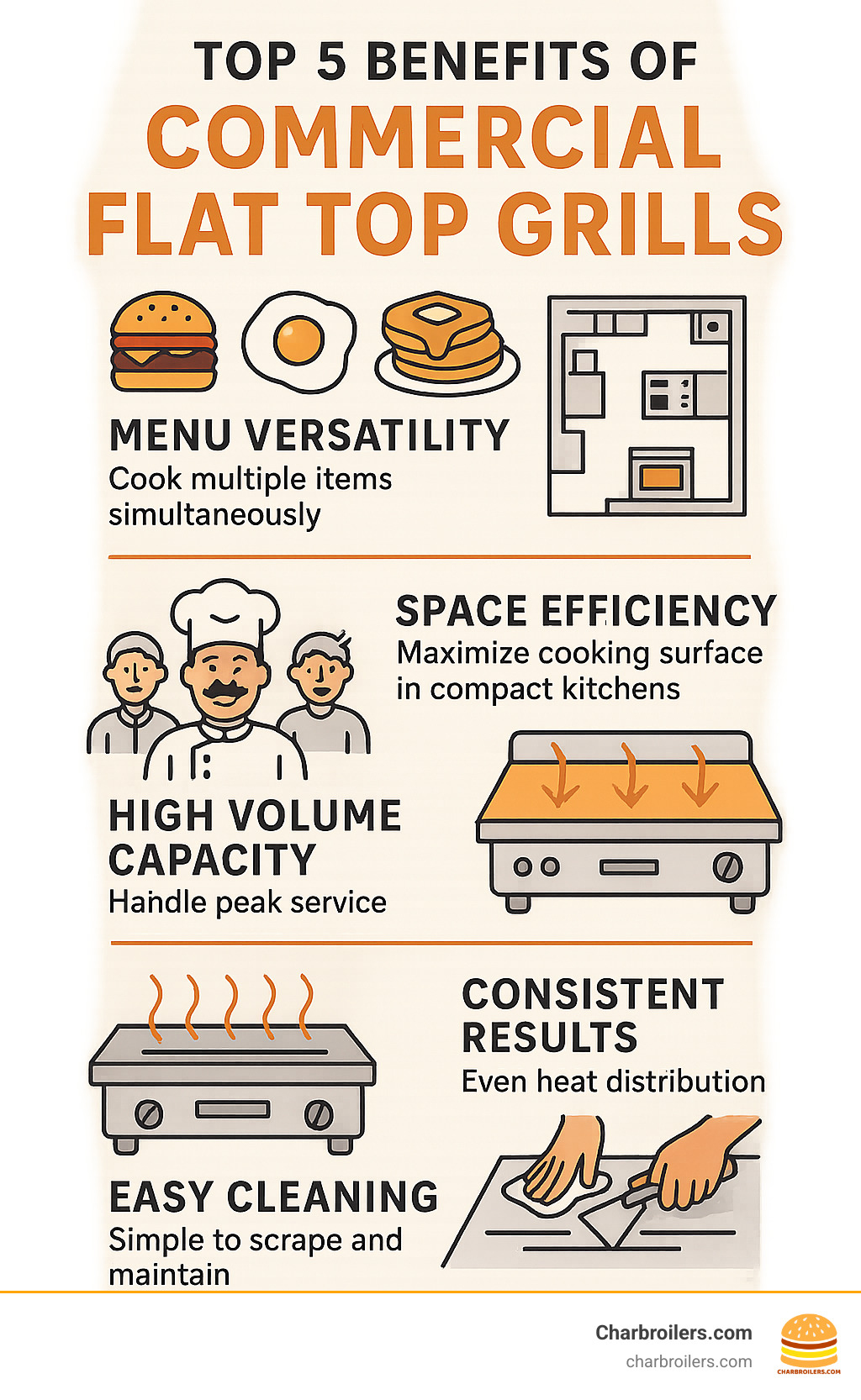
Commercial flat top grill vocab to learn:
When it comes to the primary benefits of using a commercial flat top grill, it's all about versatility and efficiency. Imagine whipping up a full breakfast spread—home fries, eggs, pancakes, and bacon—all at once. Quality griddles allow for simultaneous cooking of different food items, even with varying heat zones, which significantly boosts throughput during peak hours.
Beyond breakfast, a griddle is perfect for searing burgers, cooking grilled cheese sandwiches, preparing Philly cheesesteaks, and even delicate items like fish. Its flat, even surface ensures consistent cooking results, leading to happy customers and less wasted food. For high-volume operations, the ability to cook large batches quickly is a game-changer, leading to shorter wait times and a healthier bottom line.
Decoding Griddle Types and Power Sources
Choosing the right commercial flat top grill starts with understanding the different types and their power sources. Your selection will depend on your kitchen's specific needs and layout.
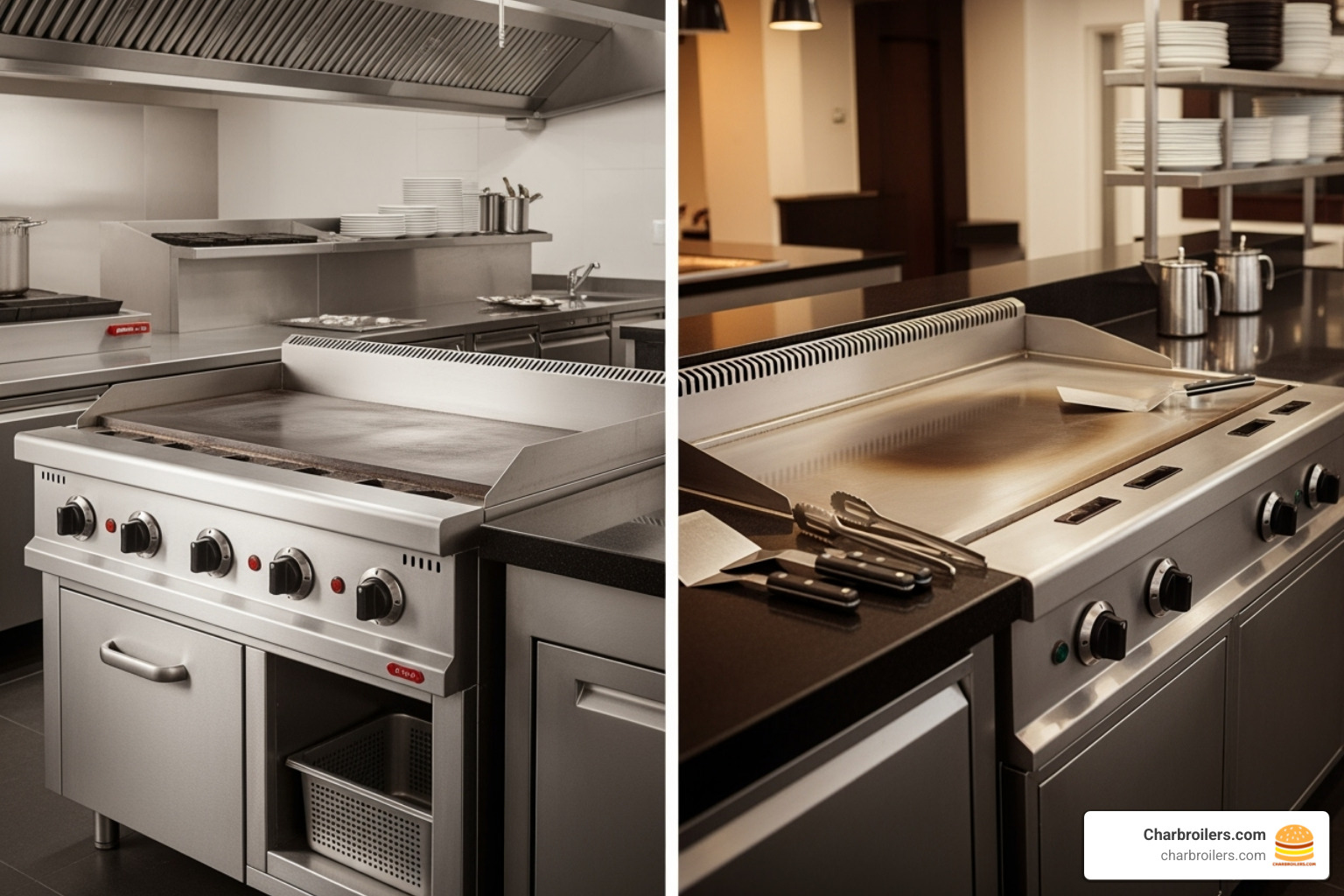
From portable countertop griddles ideal for food trucks or smaller spaces, to sleek drop-in models that integrate into your kitchen line, there's a design for every operation. For exhibition cooking, Teppanyaki grills offer a unique, customer-facing experience. Whether you need a mobile unit or a built-in powerhouse, there's a commercial flat top grill designed for you.
More info about commercial gas griddles
Gas vs. Electric: Powering Your Commercial Flat Top Grill
The choice between Gas vs. Electric is a primary consideration when selecting a commercial flat top grill. Both have distinct advantages, and the best option depends on your kitchen's existing utilities, budget, and operational preferences.
| Feature | Gas Griddles | Electric Griddles |
|---|---|---|
| Performance | Generally faster heat-up time. | Slower heat-up, but excellent heat retention and evenness. |
| Cost | Initial purchase might be lower. Gas utility costs can fluctuate. | Initial purchase often higher. Stable electrical utility costs. |
| Installation | Requires gas line connection and ventilation. Field convertible (LP/NG). | Requires electrical outlet (voltage specific). Simpler installation, often plug-in. |
| Energy Efficiency | Converts less energy to heat (some loss). BTU output is key (e.g., 30,000 BTU/burner). | Highly energy-efficient, converting almost all electrical energy into heat. |
| Heat Control | Often manual or snap-action controls. | Often thermostatic controls for precise temperature. |
Gas griddles are known for their raw power and fast heat-up times, with many models delivering 30,000 BTU per burner. A 36-inch griddle can provide 90,000 BTUs, while a 24-inch model offers 60,000 BTUs. This power ensures rapid cooking. Gas models are also flexible; many can be converted between liquid propane (LP) and natural gas (NG), and some operate without electricity, making them ideal for food trucks or locations with unreliable power.
Electric griddles are highly energy-efficient, converting nearly all electricity into heat. This can lead to lower utility costs over time. While they may heat up more slowly, they provide exceptionally consistent temperature across the cooking surface, which is ideal for delicate foods. Their precise thermostatic controls offer superior heat management, and installation is often as simple as plugging the unit into the correct electrical outlet.
Your choice between gas and electric depends on whether you prioritize the immediate power of gas or the steady, efficient control of electric. Both are excellent options for a commercial flat top grill.
Commercial Griddle Propane Picks That Sizzle
Countertop vs. Drop-In Models
The physical setup of your commercial flat top grill is crucial for kitchen workflow. The two main types are countertop models and drop-in models.
Countertop griddles offer maximum flexibility. They sit on existing counters or refrigerated bases, allowing you to place them wherever you need extra cooking capacity. Their portability makes them a popular choice for food trucks, catering, and smaller kitchens where space is at a premium. This design also simplifies movement for thorough cleaning.
Drop-in models provide a sleek, built-in look by mounting flush with your countertop. This seamless integration maximizes cooking space and is often seen in upscale or open-kitchen concepts. Hibachi-style Teppanyaki griddles are a popular type of drop-in model, featuring a hot center for cooking and cooler edges for holding. As permanent installations, they require careful planning before being placed.
Countertop Champions: The Ultimate Commercial Gas Grill Roundup
Key Factors in Choosing Your Commercial Flat Top Grill
After deciding on the type and power source, several key factors will determine the right commercial flat top grill for your operation.
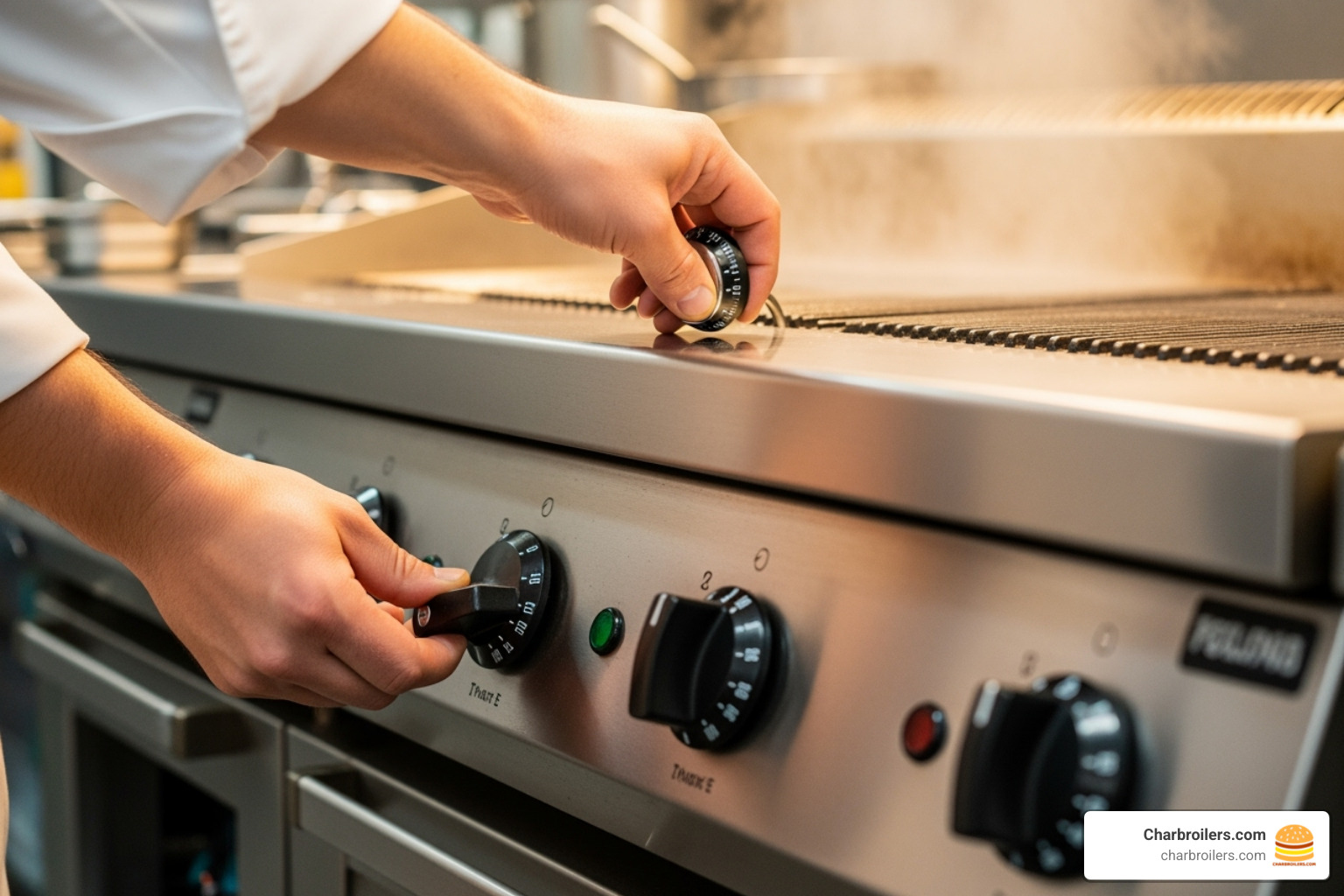
The three most important factors are sizing, plate material and thickness, and control styles. Each directly impacts performance, longevity, and food quality. Getting these details right ensures your griddle works with your kitchen, not against it.
What Size Commercial Flat Top Grill Do You Need?
The right size depends on your hood size, menu complexity, peak volume, and available space. Your ventilation hood must extend at least 6 inches beyond the griddle on all sides to capture heat, steam, and grease effectively.
Your menu dictates the required surface area. A breakfast-focused diner cooking multiple items simultaneously will need a 36-inch or 48-inch griddle to keep up with demand. In contrast, a small café using a griddle for sandwiches may only need a compact 24-inch griddle.
BTU output scales with size. A 24-inch model typically offers 60,000 BTU, a 36-inch model provides 90,000 BTU, and a 48-inch model can deliver 96,000 BTU or more, providing the power needed for high-volume cooking. Choosing the right size matches your equipment to your workflow, optimizing efficiency.
Example spec sheet for a 24-inch griddle
48-inch Commercial Flat Top Grill Guide: Cooking Up Success
Griddle Plate Deep Dive: Material and Thickness
The cooking surface's material and thickness are critical for performance.
Steel plates are durable workhorses that heat up fast and conduct heat well, making them ideal for high-heat searing. They require proper seasoning to develop a natural non-stick surface but may radiate more heat into the kitchen.
Chrome plates offer superior heat retention and even distribution, which is excellent for delicate items like eggs and fish. Food releases more easily from chrome, simplifying cleanup. However, they require more careful handling to prevent scratches and typically have a higher upfront cost.
Plate thickness determines heat retention and recovery. 1/2-inch plates are light-duty and heat quickly but may lose temperature when loaded with cold food. 3/4-inch plates are a good all-purpose option for most kitchens. For high-volume operations or cooking frozen items, 1-inch plates are ideal. They hold heat exceptionally well and recover temperature quickly, ensuring consistent performance during peak hours.
Example spec sheet for a 36-inch griddle
Manual vs. Thermostatic Controls
Choosing between manual and thermostatic controls depends on your budget, menu, and desired level of precision.
Manual controls directly adjust the gas flow or electric current. They are less expensive and allow experienced cooks to create different temperature zones across the griddle surface for zonal cooking. Many chefs prefer the direct, responsive feel of manual controls.
Thermostatic controls provide precision and consistency by automatically maintaining a set temperature, typically from 200°F to 550°F. This is invaluable for dishes requiring specific heat levels and can lead to energy savings, as the unit only uses the power needed to hold the target temperature. The choice depends on whether you value hands-on control or set-it-and-forget-it reliability.
Maintenance, Safety, and Getting the Most From Your Griddle
Your commercial flat top grill is a durable workhorse, but proper maintenance is essential for it to perform at its best. A well-cared-for griddle can serve your kitchen for around 10 years, making routine cleaning a worthwhile investment.
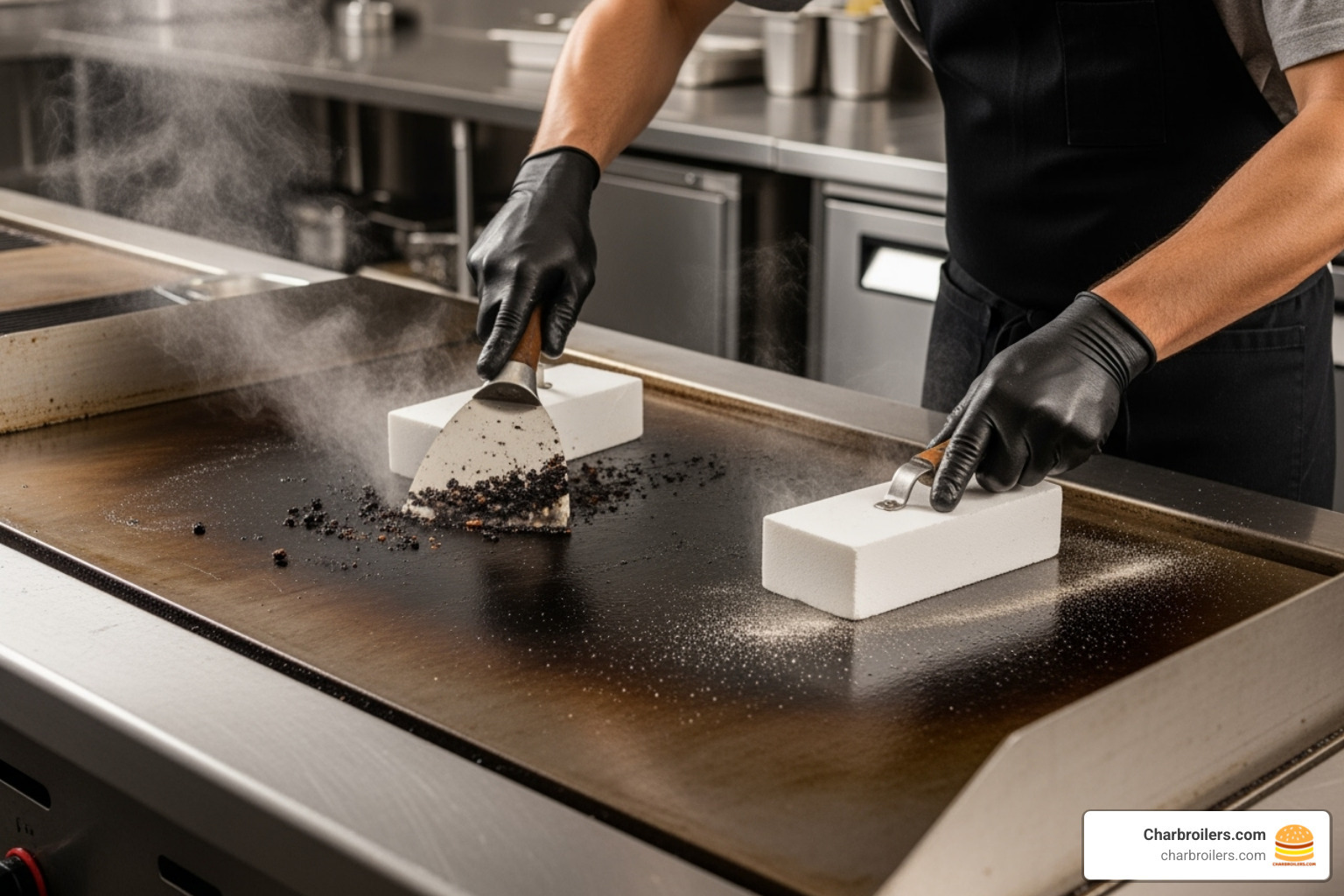
Regular cleaning prevents buildup that affects food quality and creates safety hazards, while proper seasoning maintains a high-performance cooking surface.
Best Practices for Cleaning and Maintenance
With the right routine, cleaning your commercial flat top grill is a quick task that protects your investment.
- Daily Cleaning: While the griddle is still warm, use a scraper to push debris into the grease trap. Apply a commercial griddle cleaner as directed, then scrub with griddle bricks or non-abrasive pads to remove carbon buildup.
- Deep Cleaning: A more thorough degreasing may strip the seasoning, requiring you to re-season the plate. This process rebuilds the protective, non-stick layer.
- Grease Trap Management: Regularly empty and clean the drip tray to prevent overflow, slip hazards, and pests.
- Regular Inspection: Periodically check the griddle plate for warping, deep scratches, or uneven heating that may require professional service.
The Ultimate Guide to Cleaning a Commercial Stainless Steel Griddle
Operating Safely and Considering a Used Griddle
Safe operation of a commercial flat top grill is critical in a busy kitchen.
- Ventilation: Ensure your exhaust hood extends at least 6 inches beyond the griddle on all sides to prevent smoke buildup and reduce fire risk.
- Safety Features: Use the built-in splash guards to protect staff and surfaces from grease burns. Always use heat-resistant gloves and proper tools when working with surfaces that can reach 550°F.
- Fire Safety: Keep a Class K fire extinguisher nearby. Regular cleaning of the griddle and exhaust system is the best way to prevent grease fires.
Used griddle considerations can be a budget-friendly option, but require careful evaluation. Use an inspection checklist to examine the plate for warping, check burners for corrosion, and test all controls. Look for sturdy stainless steel construction. While a full warranty is unlikely, some suppliers offer certified used equipment with limited coverage. It's wise to have a qualified technician inspect any used unit before purchase to avoid hidden problems.
Frequently Asked Questions about Commercial Griddles
Here are answers to some of the most common questions about choosing and using a commercial flat top grill.
How do you season a new commercial griddle?
Seasoning creates a natural non-stick surface on your new commercial flat top grill. The process involves bonding oil to the metal through heat.
- Clean the surface: Start by washing the new griddle with warm, soapy water to remove any protective coatings from the factory. Rinse and dry it completely.
- Apply oil: Spread a thin, even layer of a high-smoke-point oil (like canola or flaxseed oil) across the entire cooking surface.
- Heat the griddle: Turn the griddle on to about 350°F. Let the oil heat until it starts to smoke and polymerize, which takes about 15-30 minutes. This process creates the non-stick layer.
- Repeat: Let the griddle cool completely, then repeat the process 2-3 more times to build a durable, seasoned surface.
How does griddle plate thickness affect cooking?
Plate thickness directly impacts heat retention and recovery time, which is crucial during busy service.
- Thicker plates (3/4" to 1") offer better heat retention and faster recovery. When cold or frozen food is placed on the surface, the temperature remains stable, ensuring consistent cooking. They also provide more even temperature distribution, eliminating hot spots. This makes them ideal for high-volume kitchens.
- Thinner plates heat up faster but also lose heat more quickly. They are more responsive to temperature changes, which can be a disadvantage during peak hours when consistency is key. They are often found on budget models and may not be suitable for demanding commercial use.
What are the most important features to look for?
When shopping for a commercial flat top grill, prioritize these key features for the best performance and longevity:
- Durable Construction: Look for a stainless steel body that can withstand the demands of a commercial kitchen.
- High BTU per Burner: A high output, such as 30,000 BTU per burner, ensures fast heat-up and recovery times.
- Effective Grease Management: A well-designed grease trough and a large, removable drip tray are essential for cleanliness and safety.
- Precise Controls: Thermostatic controls provide consistent temperatures (often 150°F to 550°F), which is crucial for food quality. Manual controls offer simplicity and zonal cooking capabilities.
- Thick, Polished Griddle Plate: A plate that is 3/4" to 1" thick, made of either steel or chrome, ensures even heating, good food release, and fast recovery.
Sizzle Your Way to Success
Now that you understand the key factors in choosing a commercial flat top grill, you can make a smart investment that will boost your kitchen's operations. The right griddle is more than just equipment; it's a secret weapon for culinary success.
The versatility and efficiency of a quality commercial flat top grill are best. One unit can handle breakfast, lunch, and dinner service, adapting to any item on your menu, from delicate eggs to high-sear burgers.
Matching the griddle to your menu is essential. A small café may thrive with a 24-inch countertop unit, while a high-volume restaurant might require a 48-inch powerhouse. Finding the perfect fit is key.
Remember the importance of maintenance. Daily cleaning and proper seasoning are the foundation of consistent performance, food safety, and a long lifespan for your investment.
Your choice of a gas or electric, countertop or drop-in, and manual or thermostatic griddle will shape your kitchen's workflow and bottom line. Each decision contributes to your success.
At Charbroilers.com, we understand how the right equipment transforms a business. We offer a wide selection and financing options to help you build a foundation for culinary excellence.
Ready to upgrade your kitchen? Your perfect commercial flat top grill is waiting. Make the choice that will keep your customers coming back for more.
